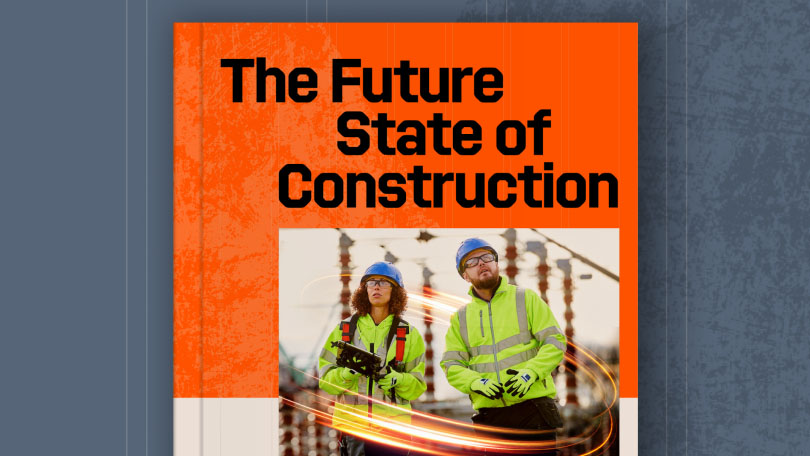— 7 min read
Managing Construction Risk: Who’s Really Accountable?

Last Updated Aug 28, 2025

Paul McSoley
Director
Paul has worked within construction for over 25 years from an Apprentice through to a Technical and Compliance Director within large UK construction businesses. He now leads his own consultancy business. He has been an active participant within the industry and a part of various technical committees for several years. He is an advocate of passing on his expertise and experience years to support the wider industry through steering committees, technical leadership, and knowledge shares.

Zoe Mullan
27 articles
Zoe Mullan is an experienced content writer and editor with a background in marketing and communications in the e-learning sector. Zoe holds an MA in English Literature and History from the University of Glasgow and a PGDip in Journalism from the University of Strathclyde and lives in Northern Ireland.
Last Updated Aug 28, 2025

Risk is inherent in construction work – something that few construction professionals need reminding of. However, the construction industry currently suffers from a critical education gap: people don't truly understand what risks are, where they develop, or what they mean.
This problem stems largely from involving experts too late in the design process. Teams often procure required specialisms after key design decisions have already been made. Consider Contractor's Design Portions (CDPs) and their effect on building shape and form. Should we introduce these at stage 5, or does bringing in experts at stage 2, 3, or 4 make more sense?
Too often, teams create risk registers to satisfy internal compliance requirements when expert specialisms aren't present. They then conduct their own due diligence based on existing team knowledge, attempting to prevent serious problems. What today's construction professionals must relearn is this: the first domino creates the risk, not the last one to fall.
Table of contents
When 'Known' Problems Mask as Risks
The infamous 'Walkie Scorchie' incident perfectly illustrates this misunderstanding of risk. Designers and builders created London's Walkie Talkie skyscraper in such a way that light reflecting from the glass melted parts of a luxury car parked beneath it. Using the domino analogy, the risk didn't manifest when light bounced off the windows and caused damage. Instead, it was inherent in the design from the very beginning of the project.
The skillset in construction has become so depleted that people don't understand what risk is anymore.

Paul McSoley
Director
PMCSTECH CONSULT LTD
If teams had conducted proper risk analysis, they wouldn't have seen this as a risk at all. A technical evaluation of the reflective nature of the curved glass would have identified the situation as a ‘known’ – something that's not a risk, but bound to happen. This highlights the core problem: too many 'knowns' find their way into risk registers, only to be swept under the proverbial office rug. Many failures like this become embedded in projects long before dashboards or office meetings flag them as potential disasters.
How Legislation has Shifted Risk Accountability
Over recent decades, legislation and compliance requirements have fundamentally redefined who bears legal accountability for risk. The Regulatory Reform (Fire Safety) Order 2005 serves as a prime example, as it transformed fire safety law entirely.
This order shifted focus from fire certificates issued by local authorities – which relied on building control departments monitoring construction – to risk assessments conducted by building operators themselves. The legislation placed responsibility on a 'responsible person' for fire safety in nearly all non-domestic buildings, plus the communal parts of multi-occupied residential buildings. Crucially, this 'responsible person' became the person controlling the building after project handover.
This change meant construction teams remained heavily reliant on building control processes to identify and remove risks before 2005, yet didn't always understand they bore accountability for compliance after 2005. The trend towards self-certification compounded this problem, as construction teams continued using building control as if they were the all-seeing eyes of design and compliance.
The Unintended Consequences of Product Regulations
Subsequently, The Construction Products Regulations 2013 emerged, ensuring that products sold in the EU must meet regulated standards across the bloc. This enabled common testing, classification, and CE marking of products. While initially intended to reduce risk by creating compliant products through a common approach, these regulations effectively created another problem.
People began viewing CE marking as confirmation that a product was compliant for any situation. However, products have variants, and CE marking doesn't mean suitability for every application. Think of it like knowing a CE tomato is a fruit and then specifying it into a fruit salad – context and suitability matter.
Consequently, risk transfer spiked, along with confusion over accountability or competency for decisions. Recognising that these errors were occurring (as products can be complex), Contractor Design Portions (CDPs) appeared more readily. Teams introduced them to provide greater flexibility in project delivery, but they had a similar effect – now the metaphorical tomato was being added just before fixing the lid onto the tin.
Consultants began using CDPs to push core design decisions and risk responsibility downstream. Only with the Building Safety Act 2022 has the construction industry started taking a focused look at risk again, re-tightening liability by extending it for building safety defects.
If you pass the risk to the nth degree, your building design is no longer spatially correct or safe. But you’re not going to see it till you go onto the site.

Paul McSoley
Director
PMCSTECH CONSULT LTD
This shifting risk landscape, combined with an ageing workforce lacking upskilling investment, has created a complicated and problematic relationship with risk that the construction industry must resolve.
Why Design Timing Determines Risk Levels
When design lags behind procurement, risk grows exponentially. While pre-construction and design phases have become more intensive, consultant skillsets aren't developing at the pace needed to manage risk effectively at this stage.
This represents a systemic issue: experienced consultants are retiring or leaving the industry, while less experienced professionals aren't gaining the experience, deep technical training, and investment they need. Meanwhile, product standards have become more complex. As a result, a growing skills gap has emerged precisely when construction requires more expertise earlier in the design process.
This situation often forces more design into CDPs or makes it "design by contractor," creating coordination struggles across disciplines such as mechanical, engineering and plumbing (MEP), structural engineers, and internal designers. Poor coordination across these disciplines weakens design integrity, leading to more clashes, late-stage redesigns, unsuitable products, and latent defects – all of which increase risk.
People think the value is in the market, but the value is in getting the design correct from day one.

Paul McSoley
Director
PMCSTECH CONSULT LTD
How Financial Focus Amplifies Risk
A laser focus on costs instead of quality and compliance contributes significantly to the heightened risk state on construction projects. The current misunderstanding of value engineering provides an interesting example of this problem.
Value engineering as currently performed often focuses on reducing capital expenditure (CapEx) – or simply put, shaving down costs. In reality, when value engineering operates at its best, CapEx increases so that operational expenditure (OpEx) decreases.
Profit margins and budgets have become so tight that many construction companies remain preoccupied with bringing down costs. Unfortunately, this approach provides a surefire way to end up cutting corners and creating more risks.
There’s too much focus on the financial figures, without the technical rigour. To be more commercially aware, you’ve got to get more technically efficient to understand how you’re going to make a project cost-efficient.

Paul McSoley
Director
PMCSTECH CONSULT LTD
Part of this problem stems from insufficient time and care during tendering and pre-construction stages. Many teams approach pre-construction as a money-driven exercise, instead of focusing on the subcontractors and experts they need to bring on board to ensure correct design.
Add short tendering timelines (often six to ten weeks) to this approach, and you get poorly designed tender specifications, late contractor appointments, inadequate supply chain engagement, and contracts that prioritise costs at building safety's expense.
The Right Approach to Risk Management
As we've established, risk forms an intrinsic aspect of construction projects. Too often, however, the approach to risk focuses more on 'throwing it over the fence' than safely analysing and mitigating it.
Every construction company can and should take specific steps to introduce a more rigorous risk management culture. First, teams must lock in procurement early to avoid bringing contractors on late, which can wreak havoc on both design and construction. Teams also need to ensure they have the right experts on board from the beginning, providing the depth of technical expertise needed to identify, analyse, and mitigate risks.
Most importantly, companies must appoint and name competent, legally responsible designers at the appropriate time, creating clarity about responsibility. Establishing accountability and acknowledging where responsibility lies leads to a more serious and thorough attitude towards construction risk management. Otherwise, everyone becomes responsible, but no one remains accountable.
The biggest enlightenment I can offer is that if you understand who’s competent and legally responsible for your building's performance and lock them in at the appropriate time, they'll behave differently.

Paul McSoley
Director
PMCSTECH CONSULT LTD
Categories:
Preconstruction, Project Management, Risk Management, Safety and Compliance
Written by

Paul McSoley
Director | PMCSTECH CONSULT LTD
Paul has worked within construction for over 25 years from an Apprentice through to a Technical and Compliance Director within large UK construction businesses. He now leads his own consultancy business. He has been an active participant within the industry and a part of various technical committees for several years. He is an advocate of passing on his expertise and experience years to support the wider industry through steering committees, technical leadership, and knowledge shares.
View profileReviewed by

Zoe Mullan
27 articles
Zoe Mullan is an experienced content writer and editor with a background in marketing and communications in the e-learning sector. Zoe holds an MA in English Literature and History from the University of Glasgow and a PGDip in Journalism from the University of Strathclyde and lives in Northern Ireland.
View profileExplore more helpful resources

Construction Management Contracts: A Complete UK Guide
Managing construction contracts can lead to an extensive physical paper trail. Sharing contracts, getting signatures and managing timelines is difficult when teams and clients are scattered across job sites and...

Key Differences Between Contractors & Subcontractors
In UK commercial construction, main (or principal) contractors engage directly with project owners to deliver complete construction programmes, while subcontractors perform specific scopes of work under the main contractor’s management....

The Role of RFPs in UK Construction Projects
Requests for Proposals (RFPs) are a core document for construction procurement in the United Kingdom. Effective RFPs align expectations, establish clear evaluation criteria, and create accountability between clients and contractors....

Financial Management in Construction Projects
Effective financial management can make or break construction projects. Teams that master budgeting, cash flow and cost control are better positioned to deliver projects on time, within budget and with...
